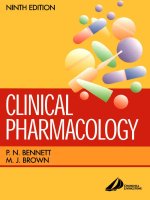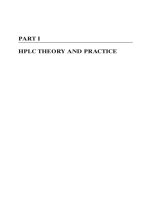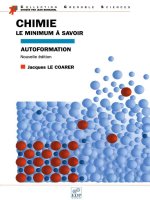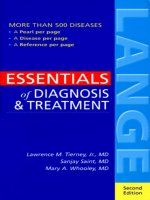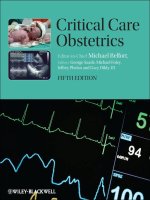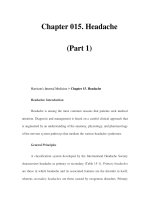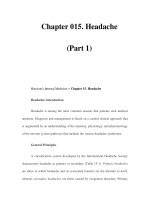Chapter 021. Syncope (Part 1) docx
Bạn đang xem bản rút gọn của tài liệu. Xem và tải ngay bản đầy đủ của tài liệu tại đây (16.37 KB, 8 trang )
Chapter 021. Syncope
(Part 1)
Harrison's Internal Medicine > Chapter 21. Syncope
Syncope: Introduction
Syncope, a transient loss of consciousness and postural tone due to reduced
cerebral blood flow, is associated with spontaneous recovery. It may occur
suddenly, without warning, or may be preceded by symptoms of faintness
("presyncope"). These symptoms include lightheadedness, dizziness, a feeling of
warmth, diaphoresis, nausea, and visual blurring occasionally proceeding to
transient blindness. Presyncopal symptoms vary in duration and may increase in
severity until loss of consciousness occurs, or they may resolve prior to loss of
consciousness if the cerebral ischemia is corrected. The differentiation of syncope
from seizure is an important, sometimes difficult, diagnostic problem.Syncope
may be benign when it occurs as a result of normal cardiovascular reflex effects on
heart rate and vascular tone, or serious when due to a life-threatening cardiac
arrhythmia. Syncope may occur as a single event or may be recurrent. Recurrent,
unexplained syncope, particularly in an individual with structural heart disease, is
associated with a high risk of death (40% mortality within 2 years).
Pathophysiology
Under normal circumstances systemic blood pressure is regulated by a
complex process that includes the musculature, venous valves, autonomic nervous
system, and renin-aldosterone-angiotensin system. Knowledge of these processes
is important to understanding the pathophysiology of syncope. Approximately
three-fourths of the systemic blood volume is contained in the venous bed, and any
interference in venous return may lead to a reduction in cardiac output. Cerebral
blood flow can be maintained if cardiac output and systemic arterial
vasoconstriction compensate, but when these adjustments fail, hypotension with
resultant cerebral underperfusion to less than half of normal results in syncope.
Normally, the pooling of blood in the lower parts of the body is prevented by (1)
pressor reflexes that induce constriction of peripheral arterioles and venules, (2)
reflex acceleration of the heart by means of aortic and carotid reflexes, and (3)
improvement of venous return to the heart by activity of the muscles of the limbs.
Tilting a normal person upright on a tilt table causes some blood to accumulate in
the lower limbs and diminishes cardiac output slightly; this may be followed by a
slight transitory fall in systolic blood pressure. However, in a patient with
defective vasomotor reflexes, upright tilt may produce an abrupt and sustained fall
in blood pressure, precipitating a faint.
Causes of Syncope
Transiently decreased cerebral blood flow is usually due to one of three
general mechanisms: disorders of vascular tone or blood volume, cardiovascular
disorders including obstructive lesions and cardiac arrhythmias, or cerebrovascular
disease (Table 21-1). Not infrequently, however, the cause of syncope is
multifactorial.
Table 21-1 Causes of Syncope
I. Disorders of Vascular Tone or Blood Volume
A. Reflex syncopes
1. Neurocardiogenic
2. Situational
Cough
Micturition
Defecation
Valsalva
Deglutition
3. Carotid sinus hypersensitivity
B. Orthostatic hypotension
1. Drug-induced (antihypertensive or vasodilator drugs)
2. Pure autonomic failure (idiopathic orthostatic hypotension)
3. Multisystem atrophies
4. Peripheral neuropathy (diabetic, alcoholic, nutritional, amyloid)
5. Physical deconditioning
6. Sympathectomy
7. Decreased blood volume
II. Cardiovascular Disorders
A. Structural and obstructive causes
1. Pulmonary embolism
2. Pulmonary hypertension
3. Atrial myxoma
4. Mitral valvular stenosis
5. Myocardial disease (massive acute myocardial infarction)
6. Left ventricular myocardial restriction or constriction
7. Pericardial constriction or tamponade
8. Aortic outflow tract obstruction
9. Aortic valvular stenosis
10. Hypertrophic obstructive cardiomyopathy
B. Cardiac arrhythmias
1. Bradyarrhythmias
a. Sinus bradycardia, sinoatrial block, sinus arrest, sick-sinus syndrome
b. Atrioventricular block
2. Tachyarrhythmias
a. Supraventricular tachycardia with structural cardiovascular disease
b. Atrial fibrillation with the Wolff-Parkinson-White syndrome
c. Atrial flutter with 1:1 atrioventricular conduction
d. Ventricular tachycardia
III. Cerebrovascular Disease
A. Vertebrobasilar insufficiency
B. Basilar artery migraine
IV. Other Disorders that May Resemble Syncope
A. Metabolic
1. Hypoxia
2. Anemia
3. Diminished carbon dioxide due to hyperventilation
4. Hypoglycemia
B. Psychogenic
1. Anxiety attacks
2. Hysterical fainting
C. Seizures
